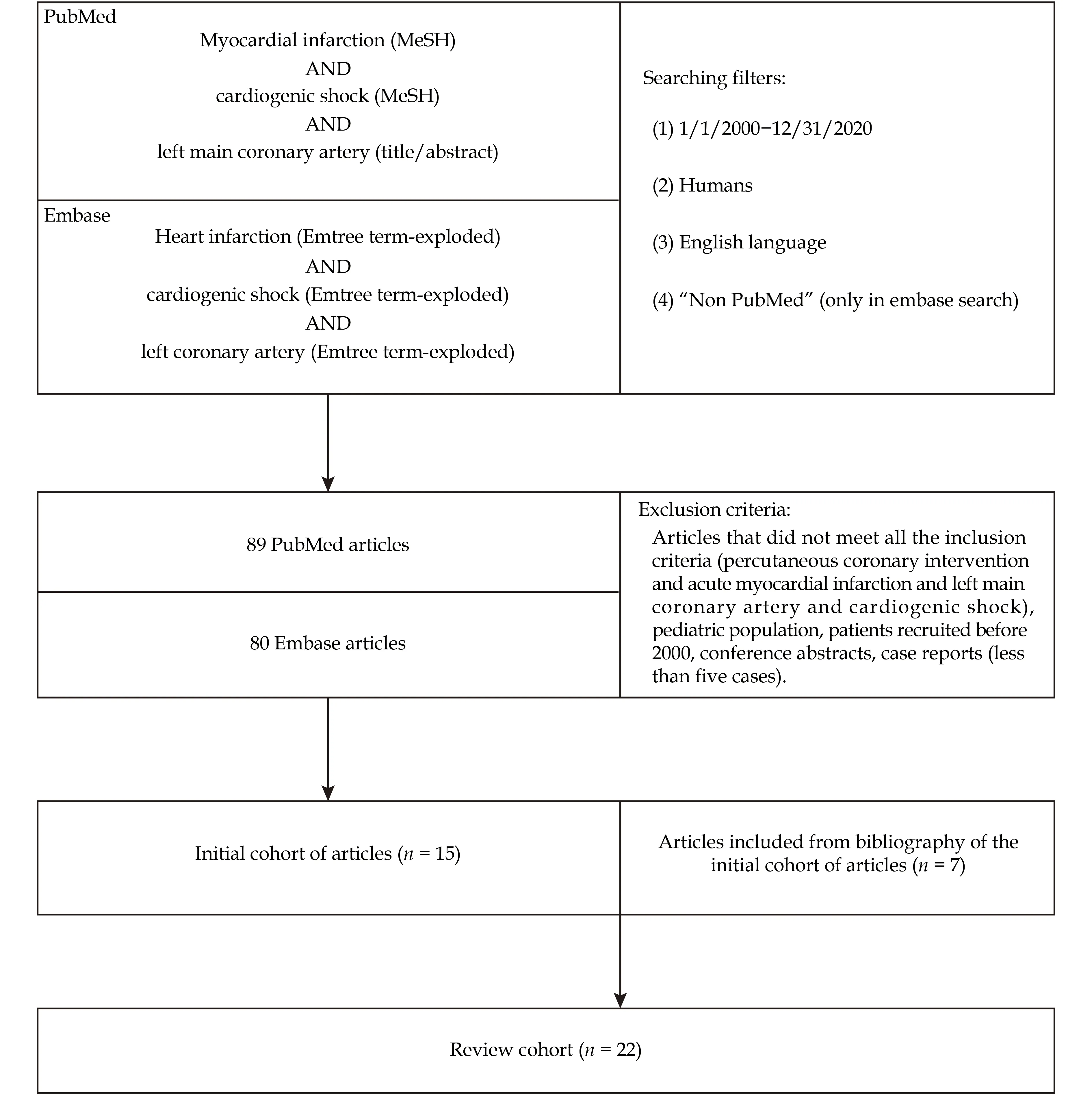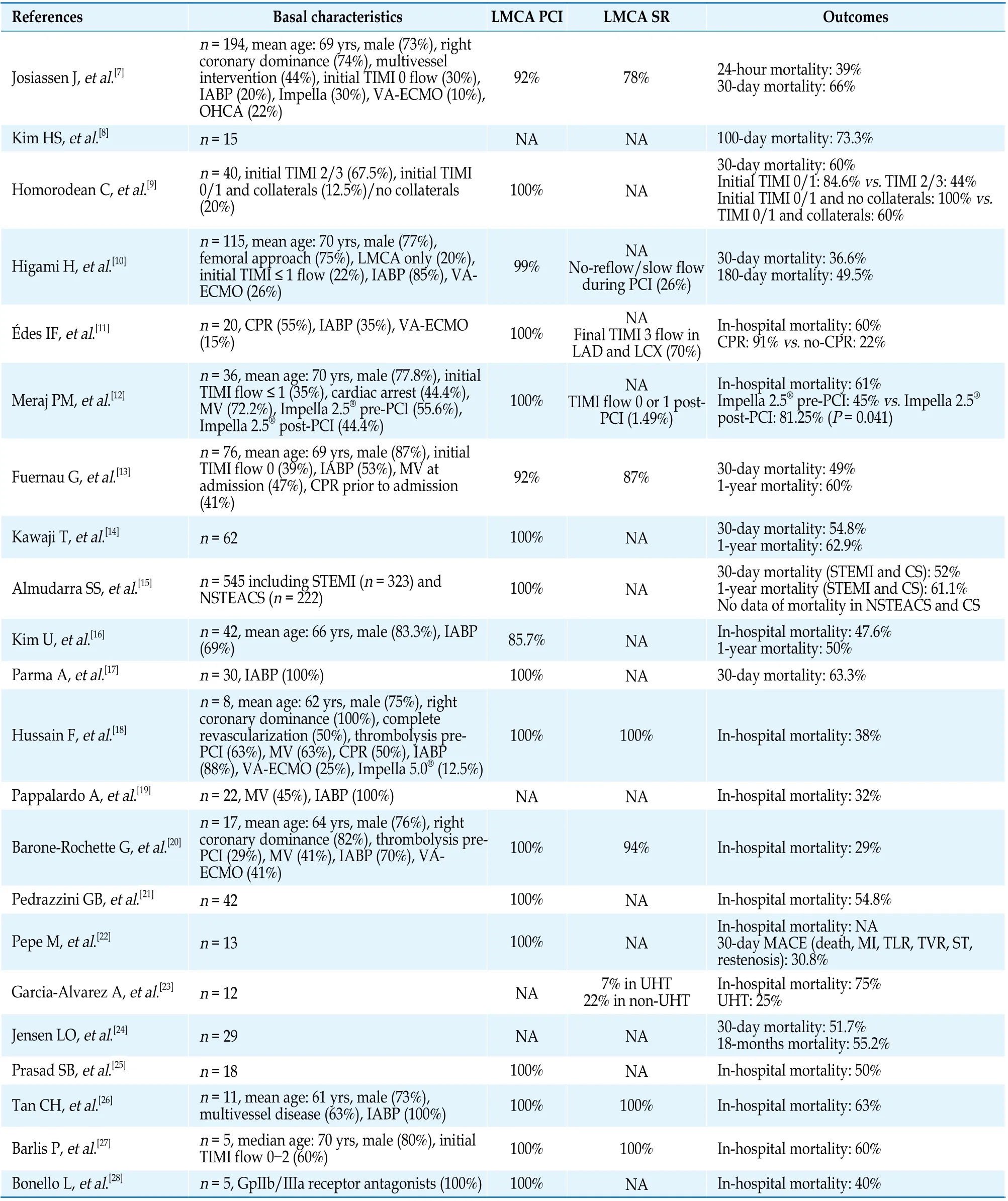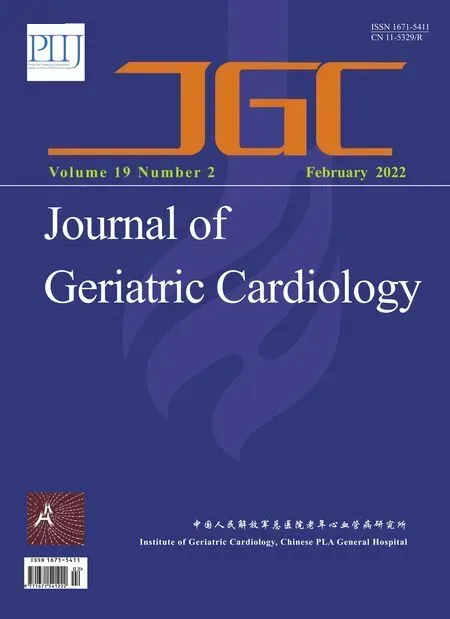Cardiogenic shock due to left main related myocardial infarction:is revascularization enough?
Francisco Galván-Román?, Elena Puerto, Roberto Martín-Asenjo, Albert Ariza-Solé
1. Department of Cardiology, Bellvitge University Hospital. Grup de Malalties Cardiovasculars. Institut d′Investigació Biomèdica de Bellvitge (IDIBELL). L’Hospitalet de Llobregat , Barcelona, Spain; 2. Department of Cardiology, Doce de Octubre University Hospital. Instituto de Investigación Sanitaria Hospital 12 de Octubre (imas12). Madrid, Spain
The incidence of cardiogenic shock (CS)complicating acute myocardial infarction(AMI-CS) remains between 3% and 10%and in-hospital mortality is hardly less than 30%.[1–3]In addition, the economic cost of caring for these patients is high.[4]Revascularization in the acute phase is the only measure that has demonstrated to modify the prognosis of AMI-CS.[5]However, data about the real prognostic impact of revascularization when the culprit lesion is the unprotected left main coronary artery (ULMCA) are scarce. The progressive development of mechanical circulatory support (MCS) is promising in this scenario. In the context of AMI-CS, an initial bridge-to-recovery strategy is used in most cases due to the belief in the reversibility of the process.[6]However, in ULMCA-related AMI-CS, recovery could be much less frequent.
Hereinafter, we present an article on the current literature analyzing the rate of short-term mortality of ULMCA-related AMI-CS, the use of MCS, and the prognostic impact of coronary revascularization in this scenario in terms of survival free from heart transplantation (HT) and permanent ventricular assist devices (PVAD).
Articles published between 1stJanuary 2000 and 31stDecember 2020 were included. The bibliographic search was carried out in PubMed and Embase databases. The search terms were myocardial infarction,CS, and left main coronary artery. Articles with pediatric population, patients recruited before 2000,case reports (less than five cases) and conference abstracts were not included. A total of 22 final articles were analyzed. The flow chart of the articles included in the review is shown in Figure 1. Characteristics of the review cohort are summarized in Table 1.
Only one of the studies specifically focused on patients with ULMCA-related AMI-CS as the main population (n= 17),[20]whereas the remainder provided information from a larger study population with a specific analysis for the ULMCA-related AMICS subgroup. All but one of the studies[13]were observational and most of them were retrospective and contained a small number of patients (range:5–545). High variability was observed in the incidence and prognosis of ULMCA-related AMI-CS,probably due to the heterogeneous definitions of ULMCA culprit lesion and CS. A significant variability in the definition of culprit left main coronary artery was found, differing from stenosis more than 50%–70% to total occlusion and the term unprotected was specified only in eight studies.[9–12,15,17,19,22]A definition of CS was not systematically explained.Sustained systolic blood pressure value below 90 mmHg was the most widespread criteria for its definition and the need of vasoactive drugs or MCS was necessary to accomplish with the diagnosis in nine articles.[7,8,12,13,15,18,22,23,27]Successful revascularization (SR) was defined only in seven studies as final thrombolysis in myocardial infarction (TIMI)flow grade ≥ 2 after percutaneous coronary intervention (PCI) and residual angiographic stenosis less than 20%–30%.[9,11,17,19,25,27,28]Successful reperfusion was reported only in some of the studies included, ranging from 74% to 100%.[7,13,18,23,26,27]

Figure 1 Flow chart of patients eligible for the article.
Data regarding the association between SR and outcomes were available in a minority of studies. In one study (n= 40), both a higher residual syntax score and a lower SYNTAX score revascularization index, which represents the proportion of coronary artery disease burden treated by PCI, were associated to higher mortality.[9]In another study (n= 74),one-year mortality or need for urgent HT for patients with postprocedural TIMI grade 3, 2, and 1 or 0 flows were 38%, 92%, and 90%, respectively (P<0.001). The adjusted analysis revealed that left main coronary artery occlusion (HR = 3.75, 95% CI: 1.09?12.84) and postprocedural TIMI < 3 grade flow (HR =3.37, 95% CI: 1.48?7.72), both were associated with poorer outcomes. However, those data were not only referred to patients with ULMCA as a culprit lesion.[23]
The use of short-term MCS other than intra-aortic balloon pump such as Impella or venoarterial extracorporeal membrane oxygenation, was described in 10 of the 22 studies analyzed, including a total of 160 patients.[7,8,10–12,14,18,20,22,23]Mortality in patients undergoing mechanical support devices(MSD) was not systematically reported. A 50% of mortality was described in one study[18]and was not
even addressed in MSD recipients in the rest of the articles.

Table 1 Summary table of the studies included in the article.
The timing of MSD implantation was not properly specified in most studies. However, in a study including 36 patients,[12]the strategies of support with Impella 2.5?before versus after PCI were compared. The authors described better survival to discharge in the pre-PCI group (55.0%vs.18.8%,P=0.041), but a higher proportion of non-ST-elevation myocardial infarction in the pre-PCI group was found.
CS is a severe clinical condition which is commonly associated to multiorgan failure and an unacceptably high rate of mortality despite current advances in management of critically ill patients.[29,30]PCI is the only measure that has shown to reduce mortality in AMI-CS. In addition, MSD are promising tools that can contribute to support the failing heart during and after revascularization, allowing the recovery process to complete.
Most studies included in this article had a small sample size, assessed different profiles of patients and had significant methodological limitations such as the fact of being observational, with different definitions of ULMCA culprit lesion and without data regarding successful reperfusion in a significant proportion of cases. Therefore, it is difficult to draw solid conclusions in this complex clinical setting, beyond the fact that patients have a significant mortality despite performing PCI. In studies where SR was achieved in 100%,[26,27]in-hospital mortality was around 60%, highlighting the possibility of an adverse prognosis regardless SR. Therefore, specifically designed, adequately powered studies are needed to properly answer this important question in ULMCA-related AMI-CS.
As stated before, MSD have emerged as essential tools for the rescue of critical patients with refractory CS. Specifically, in ULMCA-related AMI-CS, MSD may be useful during and after revascularization either for allowing the recovery process to complete or as a bridge to advanced therapies such as HT or PVAD. The description of a significant benefit of PCI in refractory ULMCA-related AMI-CS is a clinically relevant question, because the duration of support in patients on MCS is closely related to the rate of complications. The description of a lack of significant benefit of PCI in this complex clinical setting should lead to earlier initiation of HT or PVAD candidacy studies to optimize time intervals and clinical outcomes.
However, evidence about the potential benefit of MCS in this setting is scarce. The real benefit of MCS in addition to revascularization of the culprit lesion in AMI-CS has yet to be demonstrated in randomized clinical trials.[31,32]There is even less information in ULMCA-related AMI-CS, with a limited number of studies with small sample size, most of them are observational and show conflicting results.
The timing of MCS is also a matter of debate. While some authors suggest that MCS should be used after PCI in the ULMCA lesion,[11]others have described better outcomes of the “before-PCI” strategy.[12]Once again, due to the limitations of these studies, this question remains unanswered.
On the other hand, independent factors for mortality have not been directly evaluated for patients with ULMCA-related AMI-CS. The results of the studies with higher mortality[7–9,11,17,23,26,27]suggest that the initial TIMI 0 flow, cardiorespiratory arrest,and the absence of collaterals may be predictors for mortality in this setting. For instance, in the only study focused on ULMCA-related AMI-CS,[9]inhospital mortality was significantly higher when initial TIMI was 0?1 (84%vs.44%) and was especially high in cases with TIMI 0?1 and absence of collaterals (100%). Other authors have described a better prognosis in patients with shorter median symptom-to-revascularization time.[14]
Finally, one of the main issues when interpreting the results of studies in CS is the significant heterogeneity regarding the severity of shock. In this sense,no graduation of shock through validated scales such as INTERMACS[33]or SCAI[34]was detailed in any of the studies included in the review. This could lead to articles with non-strict criteria for the definition of CS to include patients who do not have a real compromise of organ perfusion. Therefore, the shortterm risk of adverse events could be underestimated.[20]On the contrary, some studies with strict definitions recruited patients with established multiorgan failure that inevitably were related to worse outcomes.[7,8,17,23,27]An accurate determination of shock severity is crucial to be addressed in future studies to compare different populations and properly interpret the results of trials and registries of AMI-CS.
To summarize, patients suffering from ULMCArelated AMI-CS have a high short-term mortality(30%?75%). Studies on this topic are scarce and have significant limitations in most cases, such as their small sample size, their observational and retrospective nature, the heterogeneity of the included patients, the lack of information about SR and the severity of shock. The available data do not allow to adequately demonstrate the prognostic impact of SR of the ULMCA nor that of MSD. Larger and specifically designed studies are needed to fully address this clinically relevant question.
ACKNOWLEDGMENTS
All authors had no conflicts of interest to disclose.
 Journal of Geriatric Cardiology2022年2期
Journal of Geriatric Cardiology2022年2期
- Journal of Geriatric Cardiology的其它文章
- Electrocardiographic and echocardiographic dyssynchrony parameters that might better predict the response to cardiac resynchronization therapy than QRS morphology and duration
- Cardiogenic shock: approaching the truth
- Fulminant myocarditis in adults: a narrative review
- The characteristic and dynamic electrocardiogram changes on hyperkalemia in a hemodialysis patient with heart failure:a case report
- Mechanical circulatory support in cardiogenic shock and postmyocardial infarction mechanical complications
- Challenges in the conduct of randomised controlled trials in cardiogenic shock complicating acute myocardial infarction
